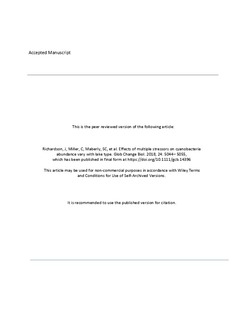| dc.description.abstract | Blooms of cyanobacteria are a current threat to global water security that is expected to increase in the future because of increasing nutrient enrichment, increasing temperature and extreme precipitation in combination with prolonged drought. However, the responses to multiple stressors, such as those above, are often complex and there is contradictory evidence as to how they may interact. Here we used broad scale data from 494 lakes in central and northern Europe, to assess how cyanobacteria respond to nutrients (phosphorus), temperature and water retention time in different types of lakes. Eight lake types were examined based on factorial combinations of major factors that determine phytoplankton composition and sensitivity to nutrients: alkalinity (low and medium‐high), colour (clear and humic) and mixing intensity (polymictic and stratified). In line with expectations, cyanobacteria increased with temperature and retention time in five of the eight lake types. Temperature effects were greatest in lake types situated at higher latitudes, suggesting that lakes currently not at risk could be affected by warming in the future. However, the sensitivity of cyanobacteria to temperature, retention time and phosphorus varied among lake types highlighting the complex responses of lakes to multiple stressors. For example, in polymictic, medium‐high alkalinity, humic lakes cyanobacteria biovolume was positively explained by retention time and a synergy between TP and temperature, while in polymictic, medium‐high alkalinity, clear lakes only retention time was identified as an explanatory variable. These results show that, although climate change will need to be accounted for when managing the risk of cyanobacteria in lakes, a “one‐size fits‐all” approach is not appropriate. When forecasting the response of cyanobacteria to future environmental change, including changes caused by climate and local management, it will be important to take this differential sensitivity of lakes into account. | nb_NO |
